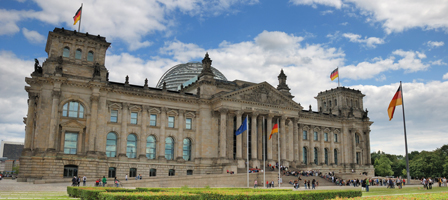Excerpt from Wikipedia, the free encyclopedia
The Reichstag building is a historical edifice in Berlin, Germany, constructed to house the Reichstag, parliament of the German Empire. It was opened in 1894 and housed the Reichstag until 1933, when it was severely damaged in a fire set by Dutch communist Marinus van der Lubbe, who was posthumously pardoned in 2008.[1] During the Nazi era, the few meetings of members of the Reichstag as a group were held in the Kroll Opera House. After the Second World War the Reichstag building fell into disuse as the parliament of the German Democratic Republic met in the Palace of the Republic in East Berlin and the parliament of the Federal Republic of Germany met in the Bundeshaus in Bonn.
The building was made safe against the elements and partially refurbished in the 1960s, but no attempt at full restoration was made until after the reunification of Germany on October 3, 1990, when it underwent reconstruction led by internationally renowned architect Norman Foster. After its completion in 1999, it became the meeting place of the modern German parliament, the Bundestag.
The term Reichstag, when used to connote a parliament, dates back to the Holy Roman Empire. The parliamentary body meeting in this building, the Reichstag or Imperial Diet — first of the North German Confederation, then of the German Empire, afterwards the Weimar Republic; and, finally, Nazi Germany — ceased to act as a true parliamentary assembly in the years of the Nazi regime (1933–1945). In today’s usage, the German term Reichstag or Reichstagsgebäude (Reichstag building) refers to the building, while the term Bundestag refers to the institution.
Text is available under the Creative Commons Attribution-ShareAlike License; additional terms may apply. See Terms of use for details.
Wikipedia® is a registered trademark of the Wikimedia Foundation, Inc., a non-profit organization.
Learn more at Wikipedia: Reichstag (building)






